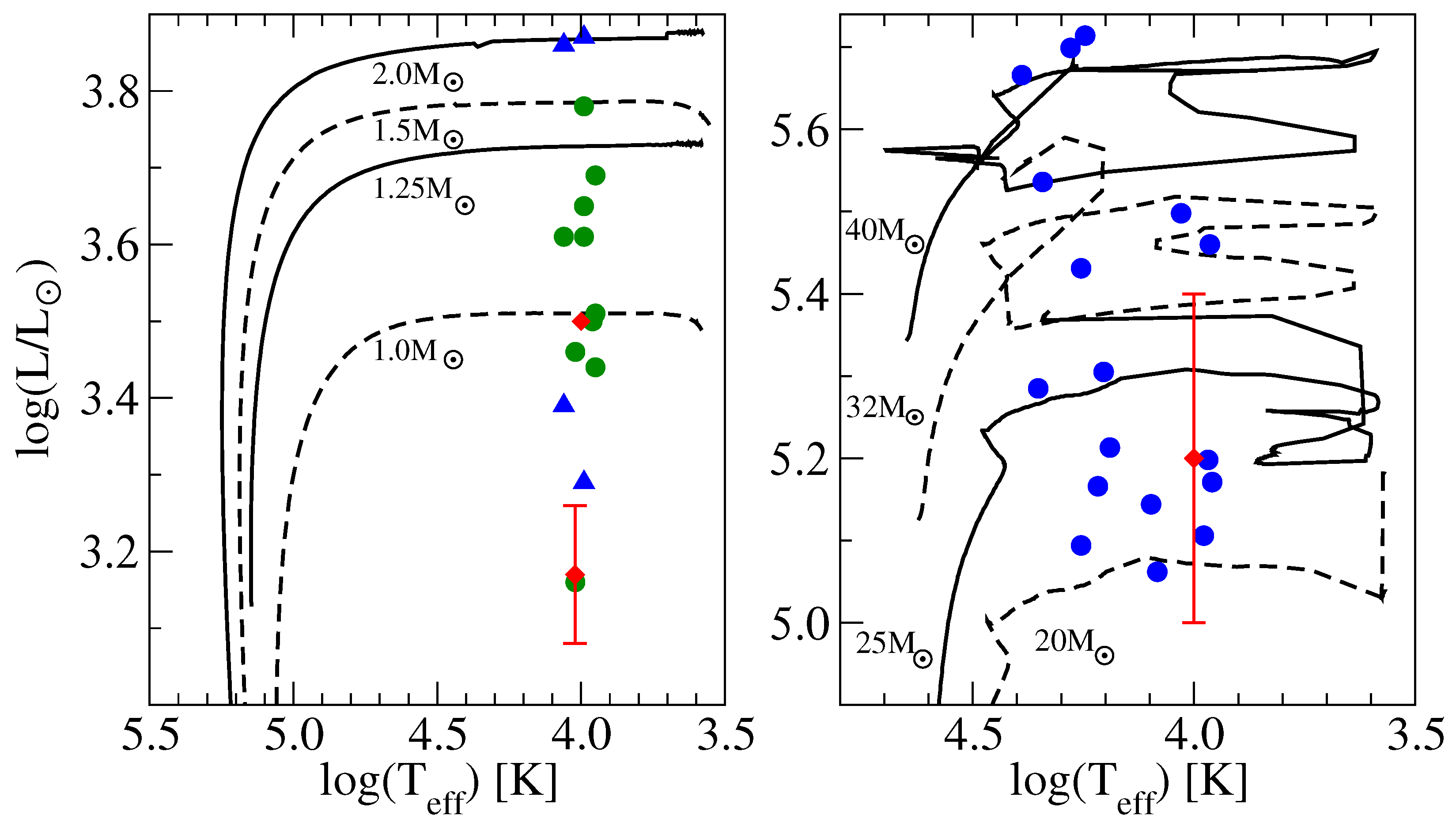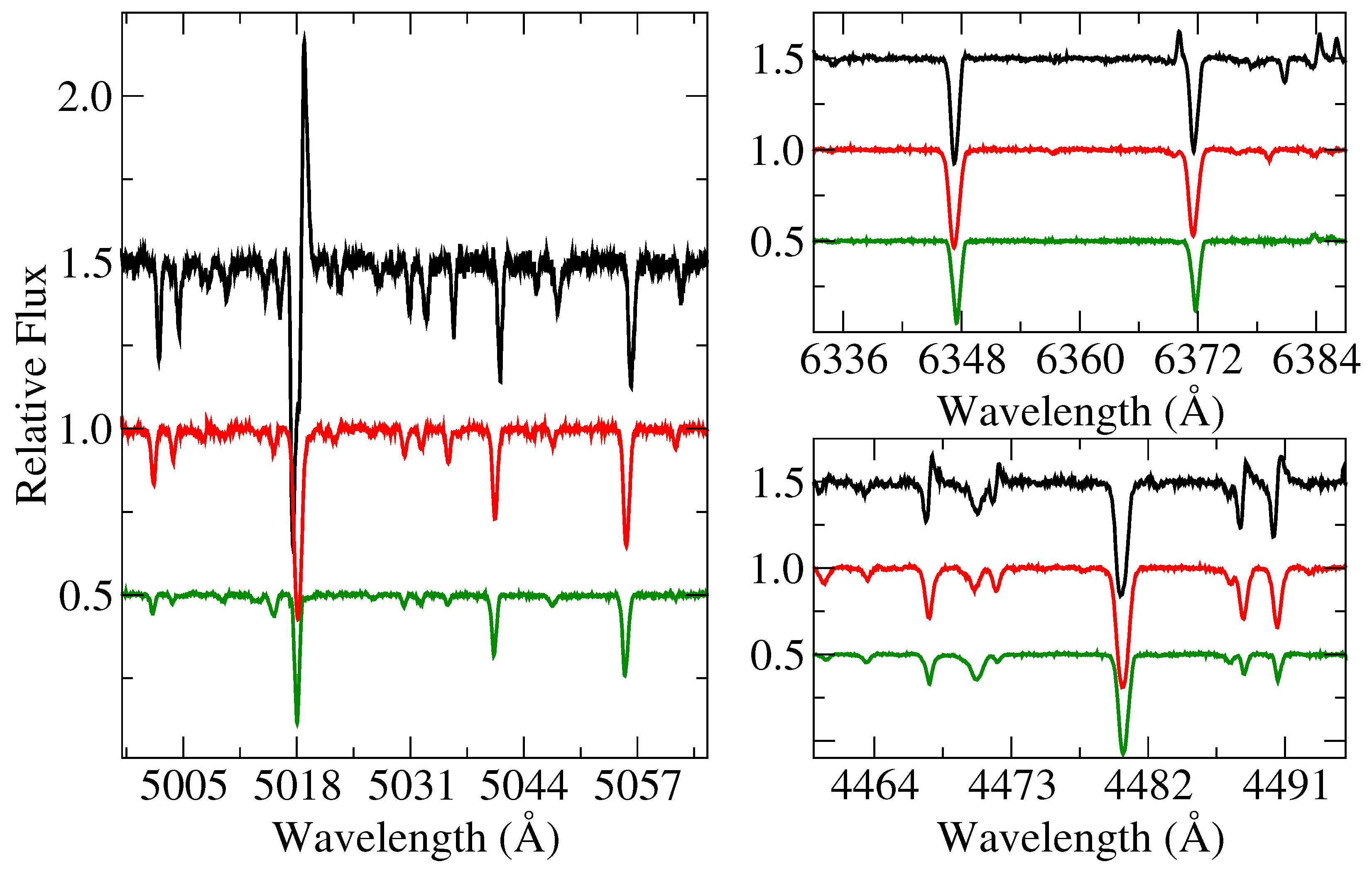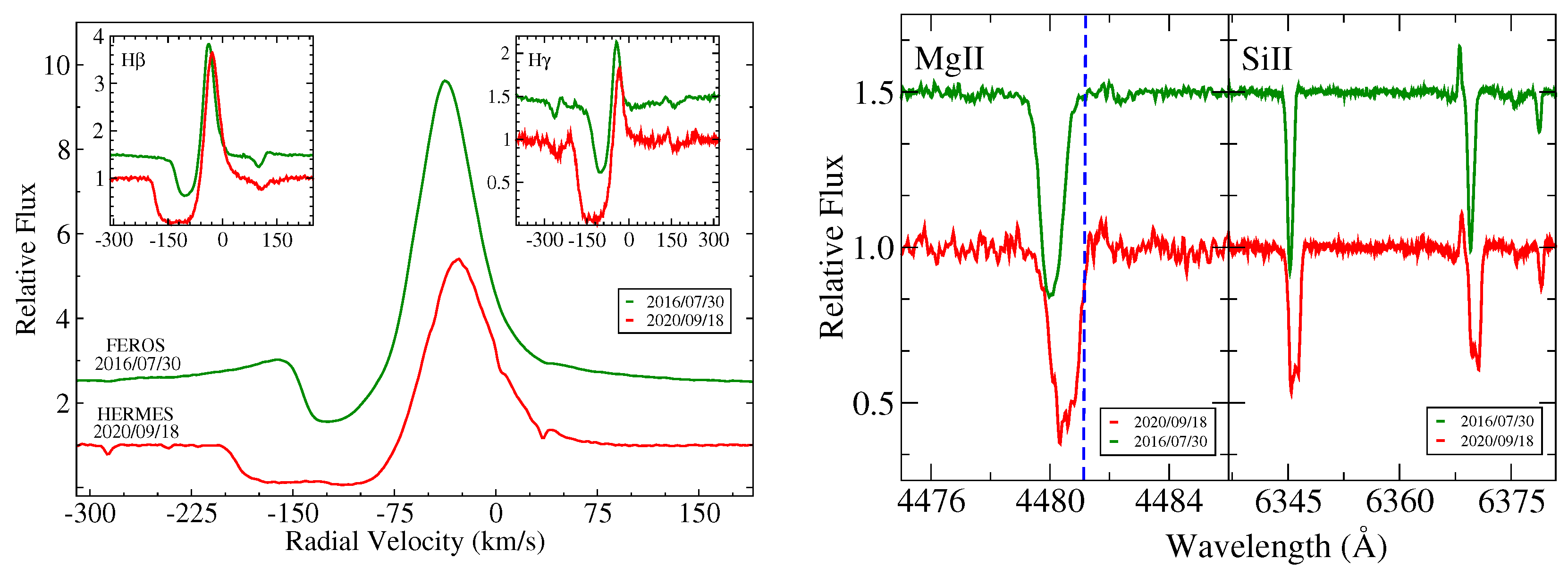AS 314: A Massive Dusty Hypergiant or a Low-Mass Post-Asymptotic Giant Branch Object?
Abstract
1. Introduction
2. Observations
3. Results
3.1. SED Modeling

3.2. Spectral Variations
4. Discussion


| Object | E | Sp.t. | Teff (K) | Ref. | |
|---|---|---|---|---|---|
| HD 91533 | 0.33 | A2Iab/b | 9100 ± 150 | 5.171 ± 0.133 | [41] |
| HD 172324 | 0.06 | A0Iabe | 10,000 | 3.54 | [9] |
| AS314 | 0.9 | A0 ia+ | 9000 | 5.2 ± 0.2 | [4] |
| AS314 | - | - | - | 3.5 | [8] |
| AS314 | - | - | 10,500 | 3.17 ± 0.09 | [9] |
| AS314 | - | B9 iae | 10,500 | - | [43] |
5. Conclusions
Author Contributions
Funding
Data Availability Statement
Acknowledgments
Conflicts of Interest
Abbreviations
References
- Merrill, P.W.; Burwell, C.G. Additional Stars whose Spectra have a Bright H α Line. APJ 1950, 112, 72. [Google Scholar] [CrossRef]
- Hiltner, W.A.; Iriarte, B. Photometric and Spectroscopic Studies of Early-Type Stars Between Galactic Longitude L = 338° and L = 33°. APJ 1955, 122, 185. [Google Scholar] [CrossRef]
- Kozok, J.R. Distances, reddenings and distribution of emission B-stars in the galactic centre region L <= 45. A&A Suppl. Ser. 1985, 62, 7–16. [Google Scholar]
- Miroshnichenko, A.S.; Chentsov, E.L.; Klochkova, V.G. AS 314: A dusty A-type hypergiant. A&A Suppl. Ser. 2000, 144, 379–389. [Google Scholar] [CrossRef]
- Chentsov, E.L.; Ermakov, S.V.; Klochkova, V.G.; Panchuk, V.E.; Bjorkman, K.S.; Miroshnichenko, A.S. An atlas of spectra of B6-A2 hypergiants and supergiants from 4800 to 6700 Å. A&A 2003, 397, 1035–1042. [Google Scholar] [CrossRef]
- Venn, K.A.; Smartt, S.J.; Lennon, D.J.; Dufton, P.L. New identifications for blue objects towards the Galactic center: Post-AGB stars, Be/disk stars and others. A&A 1998, 334, 987–999. [Google Scholar]
- Bailer-Jones, C.A.L.; Rybizki, J.; Fouesneau, M.; Demleitner, M.; Andrae, R. Estimating Distances from Parallaxes. V. Geometric and Photogeometric Distances to 1.47 Billion Stars in Gaia Early Data Release 3. AJ 2021, 161, 147. [Google Scholar] [CrossRef]
- Smith, N.; Aghakhanloo, M.; Murphy, J.W.; Drout, M.R.; Stassun, K.G.; Groh, J.H. On the Gaia DR2 distances for Galactic luminous blue variables. Mon. Not. R. Astron. Soc. 2019, 488, 1760–1778. [Google Scholar] [CrossRef]
- Parthasarathy, M.; Matsuno, T.; Aoki, W. Gaia DR2 data and the evolutionary status of eight high-velocity hot post-AGB candidates. Publ. Astron. Soc. Jpn. 2020, 72, 99. [Google Scholar] [CrossRef]
- Gaia Collaboration; Brown, A.G.A.; Vallenari, A.; Prusti, T.; de Bruijne, J.H.J.; Babusiaux, C.; Bailer-Jones, C.A.L.; Biermann, M.; Evans, D.W.; Eyer, L.; et al. Gaia Data Release 2. Summary of the contents and survey properties. A&A 2018, 616, A1. [Google Scholar] [CrossRef]
- Mahy, L.; Lanthermann, C.; Hutsemékers, D.; Kluska, J.; Lobel, A.; Manick, R.; Miszalski, B.; Reggiani, M.; Sana, H.; Gosset, E. Multiplicity of Galactic luminous blue variable stars. A&A 2022, 657, A4. [Google Scholar] [CrossRef]
- Klochkova, V.G.; Chentsov, E.L. The Problem of Spectral Mimicry of Supergiants. Astron. Rep. 2018, 62, 19–30. [Google Scholar] [CrossRef]
- Contarini, G.; Gratton, R. The Instrumental Profile and Straylight in the REOSC Ekar Echelle Spectrograph. In Proceedings of the European Southern Observatory Conference and Workshop Proceedings, La Serena, Chile, 21–24 January 1992; Volume 42, p. 737. [Google Scholar]
- Panchuk, V.E.; Klochkova, V.G.; Yushkin, M.V. The high-resolution Echelle Spectrograph of the 6-m telescope of the special astrophysical observatory. Astron. Rep. 2017, 61, 820–831. [Google Scholar] [CrossRef]
- Panchuk, V.E.; Najdenov, I.D.; Klochkova, V.G.; Ivanchik, A.B.; Yermakov, S.V.; Murzin, V.A. On the problem of high spectral resolution observations of faint objects. Bull. Spec. Astrophys. Obs. 1997, 44, 127–131. [Google Scholar]
- Panchuk, V.E.; Klochkova, V.G.; Galazutdinov, G.A.; Ryadchenko, V.P.; Chentsov, E.L. An echelle spectrometer with a CCD array for the 6-m telescope. Astron. Lett. 1993, 19, 431–434. [Google Scholar]
- McCarthy, J.K.; Sandiford, B.A.; Boyd, D.; Booth, J. The Sandiford 2.1 M Cassegrain Echelle Spectrograph for McDonald Observatory: Optical and Mechanical Design and Performance. Publ. Astron. Soc. Pac. 1993, 105, 881. [Google Scholar] [CrossRef]
- Kaufer, A.; Stahl, O.; Tubbesing, S.; Nørregaard, P.; Avila, G.; Francois, P.; Pasquini, L.; Pizzella, A. Commissioning FEROS, the new high-resolution spectrograph at La-Silla. Messenger 1999, 95, 8–12. [Google Scholar]
- Raskin, G.; van Winckel, H.; Hensberge, H.; Jorissen, A.; Lehmann, H.; Waelkens, C.; Avila, G.; de Cuyper, J.P.; Degroote, P.; Dubosson, R.; et al. HERMES: A high-resolution fibre-fed spectrograph for the Mercator telescope. A&A 2011, 526, A69. [Google Scholar] [CrossRef]
- Pojmanski, G. The All Sky Automated Survey. Acta Astron. 1997, 47, 467–481. [Google Scholar]
- Kochanek, C.S.; Shappee, B.J.; Stanek, K.Z.; Holoien, T.W.S.; Thompson, T.A.; Prieto, J.L.; Dong, S.; Shields, J.V.; Will, D.; Britt, C.; et al. The All-Sky Automated Survey for Supernovae (ASAS-SN) Light Curve Server v1.0. Publ. Astron. Soc. Pac. 2017, 129, 104502. [Google Scholar] [CrossRef]
- Helou, G.; Walker, D.W. (Eds.) Infrared Astronomical Satellite (IRAS) Catalogs and Atlases. Volume 7: The Small Scale Structure Catalog; NASA: Washington, DC, USA, 1988; Volume 7. [Google Scholar]
- Cutri, R.M.; Wright, E.L.; Conrow, T.; Fowler, J.W.; Eisenhardt, P.R.M.; Grillmair, C.; Kirkpatrick, J.D.; Masci, F.; McCallon, H.L.; Wheelock, S.L.; et al. Explanatory Supplement to the AllWISE Data Release Products; NASA: Washington, DC, USA, 2013. [Google Scholar]
- Egan, M.P.; Price, S.D.; Kraemer, K.E.; Mizuno, D.R.; Carey, S.J.; Wright, C.O.; Engelke, C.W.; Cohen, M.; Gugliotti, M.G. VizieR Online Data Catalog: MSX6C Infrared Point Source Catalog. The Midcourse Space Experiment Point Source Catalog Version 2.3 (October 2003); NASA: Washington, DC, USA, 2003. [Google Scholar]
- Ishihara, D.; Onaka, T.; Kataza, H.; Salama, A.; Alfageme, C.; Cassatella, A.; Cox, N.; García-Lario, P.; Stephenson, C.; Cohen, M.; et al. The AKARI/IRC mid-infrared all-sky survey. A&A 2010, 514, A1. [Google Scholar] [CrossRef]
- Herbig, G.H. The Diffuse Interstellar Bands. IX. Constraints on the Identification. APJ 1993, 407, 142. [Google Scholar] [CrossRef]
- Castelli, F.; Kurucz, R.L. New Grids of ATLAS9 Model Atmospheres. In Proceedings of the Modelling of Stellar Atmospheres; Piskunov, N., Weiss, W.W., Gray, D.F., Eds.; Astronomical Society of the Pacific: San Francisco, CA, USA, 2003; Volume 210, p. 20. [Google Scholar] [CrossRef]
- Nenkova, M.; Ivezić, Ž.; Elitzur, M. DUSTY: A Publicly Available Code for Modeling Dust Emission. In Proceedings of the Thermal Emission Spectroscopy and Analysis of Dust, Disks, and Regoliths; Sitko, M.L., Sprague, A.L., Lynch, D.K., Eds.; Astronomical Society of the Pacific: San Francisco, CA, USA, 2000; Volume 196, pp. 77–82. [Google Scholar]
- Ivezic, Z.; Elitzur, M. Self-similarity and scaling behaviour of infrared emission from radiatively heated dust—I. Theory. Mon. Not. R. Astron. Soc. 1997, 287, 799–811. [Google Scholar] [CrossRef]
- Miroshnichenko, A.; Ivezić, Ž.; Elitzur, M. On Protostellar Disks in Herbig Ae/Be Stars. Astrophys. J. 1997, 475, L41–L44. [Google Scholar] [CrossRef]
- Mathis, J.S.; Rumpl, W.; Nordsieck, K.H. The size distribution of interstellar grains. APJ 1977, 217, 425–433. [Google Scholar] [CrossRef]
- Kamath, D.; Van Winckel, H. Post-AGB Stars as Tracers of AGB Nucleosynthesis: An Update. Universe 2022, 8, 233. [Google Scholar] [CrossRef]
- Oomen, G.M.; Van Winckel, H.; Pols, O.; Nelemans, G.; Escorza, A.; Manick, R.; Kamath, D.; Waelkens, C. Orbital properties of binary post-AGB stars. A&A 2018, 620, A85. [Google Scholar] [CrossRef]
- Verdugo, E.; Talavera, A.; Gómez de Castro, A.I. Understanding A-type supergiants. I. Ultraviolet and visible spectral atlas. A&A Suppl. Ser. 1999, 137, 351–362. [Google Scholar] [CrossRef][Green Version]
- Klochkova, V.G.; Yushkin, M.V.; Miroshnichenko, A.S.; Panchuk, V.E.; Bjorkman, K.S. Discovery of spectral variation in the optical counterpart of IRAS 01005+7910. A&A 2002, 392, 143–150. [Google Scholar] [CrossRef]
- Miroshnichenko, A.S.; Zharikov, S.V.; Danford, S.; Manset, N.; Korčáková, D.; Kříček, R.; Šlechta, M.; Omarov, C.T.; Kusakin, A.V.; Kuratov, K.S.; et al. Toward Understanding the B[e] Phenomenon. V. Nature and Spectral Variations of the MWC 728 Binary System. APJ 2015, 809, 129. [Google Scholar] [CrossRef]
- Miroshnichenko, A.S. New photometric calibration of the visual surface brightness method. In Proceedings of the IAU Symposium; Bedding, T.R., Booth, A.J., Davis, J., Eds.; School of Physics, University of Sydney: Sydney, Australia, 1997; Volume 189, p. 50. [Google Scholar]
- Green, G.M.; Schlafly, E.; Zucker, C.; Speagle, J.S.; Finkbeiner, D. A 3D Dust Map Based on Gaia, Pan-STARRS 1, and 2MASS. APJ 2019, 887, 93. [Google Scholar] [CrossRef]
- Oudmaijer, R.D.; Jones, E.R.M.; Vioque, M. A census of post-AGB stars in Gaia DR3: Evidence for a substantial population of Galactic post-RGB stars. Mon. Not. R. Astron. Soc. 2022, 516, L61–L65. [Google Scholar] [CrossRef]
- Miller Bertolami, M.M. New models for the evolution of post-asymptotic giant branch stars and central stars of planetary nebulae. A&A 2016, 588, A25. [Google Scholar] [CrossRef]
- Georgy, C.; Saio, H.; Meynet, G. Blue supergiants as tests for stellar physics. A&A 2021, 650, A128. [Google Scholar] [CrossRef]
- Ekström, S.; Georgy, C.; Eggenberger, P.; Meynet, G.; Mowlavi, N.; Wyttenbach, A.; Granada, A.; Decressin, T.; Hirschi, R.; Frischknecht, U.; et al. Grids of stellar models with rotation. I. Models from 0.8 to 120 M⊙ at solar metallicity (Z = 0.014). A&A 2012, 537, A146. [Google Scholar] [CrossRef]
- Thomas, S.J.; Rodgers, B.; van der Bliek, N.S.; Doppmann, G.; Bouvier, J.; Salvo, C.A.; Beuzit, J.L.; Rigaut, F. A Survey of Herbig Ae/Be Multiplicity. AJ 2023, 165, 135. [Google Scholar] [CrossRef]


| Observatory | Tel. | Instrument | R | Location | # Sp. | Obs.Years |
|---|---|---|---|---|---|---|
| OAN SPM | 2.1 m | REOSC | 18,000 | B.C., Mexico | 1 | 2013 |
| SAO | 6 m | LYNX | 25,000 | N. Arkhyz, Russia | 2 | 1997–1999 |
| SAO | 6 m | PFES | 15,000 | N.Arkhyz, Russia | 2 | 2000–2001 |
| SAO | 6 m | NES | 60,000 | N. Arkhyz, Russia | 1 | 2002 |
| ESO | 2.2 m | FEROS | 48,000 | Chile | 1 | 2016 |
| McD | 2.1 m | Sandiford | 60,000 | Mt. Locke, TX, USA | 1 | 2001 |
| ORLM | 1.2 m | HERMES | 85,000 | La Palma, Spain | 23 | 2020–2023 |
| TCO | 0.81 m | eShel | 12,000 | NC, USA | 2 | 2023 |
Disclaimer/Publisher’s Note: The statements, opinions and data contained in all publications are solely those of the individual author(s) and contributor(s) and not of MDPI and/or the editor(s). MDPI and/or the editor(s) disclaim responsibility for any injury to people or property resulting from any ideas, methods, instructions or products referred to in the content. |
© 2025 by the authors. Licensee MDPI, Basel, Switzerland. This article is an open access article distributed under the terms and conditions of the Creative Commons Attribution (CC BY) license (https://creativecommons.org/licenses/by/4.0/).
Share and Cite
Bakhytkyzy, A.; Miroshnichenko, A.S.; Klochkova, V.G.; Panchuk, V.E.; Zharikov, S.V.; Mahy, L.; Van Winckel, H.; Agishev, A.T.; Khokhlov, S.A. AS 314: A Massive Dusty Hypergiant or a Low-Mass Post-Asymptotic Giant Branch Object? Galaxies 2025, 13, 17. https://doi.org/10.3390/galaxies13020017
Bakhytkyzy A, Miroshnichenko AS, Klochkova VG, Panchuk VE, Zharikov SV, Mahy L, Van Winckel H, Agishev AT, Khokhlov SA. AS 314: A Massive Dusty Hypergiant or a Low-Mass Post-Asymptotic Giant Branch Object? Galaxies. 2025; 13(2):17. https://doi.org/10.3390/galaxies13020017
Chicago/Turabian StyleBakhytkyzy, Aigerim, Anatoly S. Miroshnichenko, Valentina G. Klochkova, Vladimir E. Panchuk, Sergey V. Zharikov, Laurent Mahy, Hans Van Winckel, Aldiyar T. Agishev, and Serik A. Khokhlov. 2025. "AS 314: A Massive Dusty Hypergiant or a Low-Mass Post-Asymptotic Giant Branch Object?" Galaxies 13, no. 2: 17. https://doi.org/10.3390/galaxies13020017
APA StyleBakhytkyzy, A., Miroshnichenko, A. S., Klochkova, V. G., Panchuk, V. E., Zharikov, S. V., Mahy, L., Van Winckel, H., Agishev, A. T., & Khokhlov, S. A. (2025). AS 314: A Massive Dusty Hypergiant or a Low-Mass Post-Asymptotic Giant Branch Object? Galaxies, 13(2), 17. https://doi.org/10.3390/galaxies13020017







